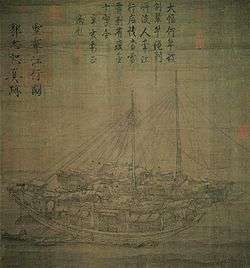Guo Zhongshu

Guo Zhongshu (Chinese: 郭忠恕; pinyin: Guō Zhōngshù; Wade–Giles: Kuo Chung-shu; ?–977) was a Chinese painter and scholar of the Five Dynasties period and Song Dynasty. He was initially a scholar-official serving the Later Han governor Liu Yun, but escaped when Liu Yun was murdered on orders of Guo Wei who usurped the Later Han throne.
Cui was born in Luoyang in the Henan province.[1] His style name was 'Shuxian' (恕先). Guo was noted for his paintings of landscapes and structures.
He is the author of the first great paleographic compilation Han jian 汗简, which, among other materials, features the inscriptions of the Stone Drums of Qin. The name of the dictionary means "making the bamboo sweet" and refers to the process of preparation of the bamboo slips for writing (so called shaqing 殺青, "killing the green" ). Despite being included into the bibliographic chapter of the Book of Song 宋書, this work was much neglected during the following dynasties. Veracity of some interpretations in the Han jian was not proven until the second half of the 20 c. [2]
References
- ↑ "Painting and Calligraphy of the Northern Song". Retrieved 2010-12-31.
- ↑ Galambos, Imre. Orthography of Early Chinese Writing: Evidence from Newly Excavated Manuscripts. Budapest, 2006:15-20.